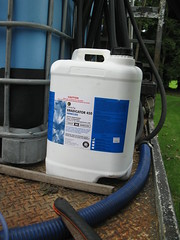 世界衛生組織下屬機構國際癌症研究機構(International Agency for Research on Cancer)本月將全世界最普遍的農藥「草甘膦」(又稱嘉磷塞)歸類為「強烈懷疑的人類致癌物」(probable human carcinogen)。
世界衛生組織下屬機構國際癌症研究機構(International Agency for Research on Cancer)本月將全世界最普遍的農藥「草甘膦」(又稱嘉磷塞)歸類為「強烈懷疑的人類致癌物」(probable human carcinogen)。
本月稍早,來自11國的17位專家在里昂IARC舉行會議,評估5種有機磷農藥的致癌性:殺蟲威、對硫磷、馬拉硫磷、二嗪磷和草甘膦,最後決議將草甘膦歸類為強烈懷疑的人類致癌物,並將結果發表於頂尖的英國醫學期刊《刺胳針》(The Lancet)。
全世界最普遍的農藥
草甘膦是一種廣譜性農藥,產量目前全世界最高,有超過750種不同的農業、林業、都市和家庭應用。
美國跨國農化與農業生計公司孟山都,1970年代推出草甘膦產品「年年春」,並和其他公司開發出基改抗草甘膦作物,讓農民可以除去雜草而不傷害作物後,草甘膦用量大增。
2007年,草甘膦是美國農業用量最多的殺草劑,總計超過84,000噸,大多用於基改玉米、大豆、棉花和甜菜。草甘膦也是美國家庭和園藝市佔率第二的殺草劑。此外,美國工業、商業和政府2007年也使用近6,800噸的草甘膦。
空氣、水、食物都可見 草甘膦疑致癌
IARC專家團體指出,草甘膦噴洒期間,空氣、水和糧食中都能發現其存在,甚至出現在農工的血液和尿液中,顯示草甘膦是會被人體吸收的。
專家指出,草甘膦對人體致癌的證據有限。研究者引述美國、加拿大和瑞典的病例對照研究,排除其他殺蟲劑的影響後,發現職業上接觸草甘膦,罹患非霍奇金氏淋巴瘤風險增加。而以大鼠為實驗對象的研究發現,接觸草甘膦的大鼠出現腎、胰腺和皮膚癌。
土壤中的微生物將草甘膦分解成AMPA。草甘膦中毒後,能在血液中檢測到AMPA,顯示腸道微生物的確會代謝草甘膦。
「草甘膦和草甘膦製劑破壞哺乳動物、人體和體外動物細胞的DNA和染色體。一篇研究發現,許多社區噴洒草甘膦製劑後,居民血液中的染色體破壞標記物(微核)增加。」
美國環保署(EPA)表示,「目前沒有明確證據可說明飲用水中含草甘膦可能致癌。」不過,EPA也發現,急性吸入高於最大污染物容許濃度(Maximum Contaminant Level, MCL)的草甘膦會導致肺充血和呼吸速率增加。
根據EPA的技術文件,長期暴露於高於MCL的草甘膦可能導致腎臟和生殖系統損壞。
農藥商不服 孟山都經理:意識形態涉入研究
孟山都對IARC的分類表示憤怒。孟山都技術長Robb Fraley表示,「這個結論和全世界權威機構數十年來的安全審核結果不符,世界權威機構皆同意市面上的草甘膦對人體是安全無虞的。這個研究結果很明顯是依某一意識型態特意挑選數據而來。」
孟山都在一項聲明中表示,「IARC的研究結果不具強制力,不影響草甘膦的標示方式及目前的註冊或使用。」
非營利倡議團體公共利益科學中心呼籲EPA重視IARC的結論,因為每年農民都使用數百萬磅的草甘膦,EPA應確保草甘膦應在不傷害農民、消費者或農場動物的情況下使用。
Glyphosate, the world’s most widely used herbicide, has been classified as a “probable human carcinogen” by the International Agency for Research on Cancer, an agency within the World Health Organization.
The new classification emerged from a meeting of 17 experts from 11 countries earlier this month at the International Agency for Research on Cancer, IARC, in Lyon. The experts met to assess the carcinogenicity of five organophosphate pesticides: tetrachlorvinphos, parathion, malathion, diazinon, and glyphosate.
Their conclusions were published in the current issue of the British medical journal “The Lancet.”
Glyphosate is a broad-spectrum herbicide, currently with the highest production volumes of any herbicide in the world. It is used in more than 750 different products for agriculture, forestry, urban, and home applications.
The publicly-traded American multinational agrochemical and agricultural biotechnology company Monsanto brought glyphosate to market in the 1970s under the trade name Roundup.
Its use has increased sharply with the development of genetically modified glyphosate-resistant crops by Monsanto and others because it allows farmers to kill weeds without killing their crops.
In 2007, glyphosate was the most used herbicide in the U.S. agricultural sector, with roughly 84,000 tons applied – most commonly to genetically engineered corn, soybeans, cotton, and sugar beets. It is the second-most used herbicide in the U.S. home and garden market with about 3,600 tons applied. In addition, industry, commerce, and government in the United States applied approximately 6,800 tons that year.
The IARC expert group said “glyphosate has been detected in air during spraying, in water, and in food.”
“Glyphosate has been detected in the blood and urine of agricultural workers, indicating absorption,” the IARC experts wrote in “The Lancet” article.
There was “limited evidence in humans for the carcinogenicity of glyphosate,” the experts said. They cited case-control studies of occupational exposure in the United States, Canada, and Sweden that reported increased risks for non-Hodgkin lymphoma that persisted after adjustment for other pesticides.
The experts cited studies of mice that showed renal, pancreatic and skin cancers following glyphosate exposure.
Soil microbes degrade glyphosate to aminomethylphosphoric acid (AMPA). Blood AMPA detection after poisonings suggests intestinal microbial metabolism in humans, the experts wrote.
“Glyphosate and glyphosate formulations induced DNA and chromosomal damage in mammals, and in human and animal cells in vitro,” the experts noted. “One study reported increases in blood markers of chromosomal damage (micronuclei) in residents of several communities after spraying of glyphosate formulations.”
Monsanto, which sells Roundup Ready genetically engineered seeds as well as the herbicide itself, reacted with anger to the IARC classification.
“We are outraged with this assessment,” said Dr. Robb Fraley, Monsanto’s chief technology officer. “This conclusion is inconsistent with the decades of ongoing comprehensive safety reviews by the leading regulatory authorities around the world that have concluded that all labeled uses of glyphosate are safe for human health. This result was reached by selective ‘cherry picking’ of data and is a clear example of agenda-driven bias.”
The U.S. Environmental Protection Agency says, “There is inadequate evidence to state whether or not glyphosate has the potential to cause cancer from a lifetime exposure in drinking water.”
However, the EPA has found congestion of the lungs and an increased breathing rate can result from acute exposures at levels above the Maximum Contaminant Level, MCL.
“Glyphosate has the potential to cause the following health effects from long-term exposures at levels above the MCL: kidney damage, reproductive effects,” the EPA says in a technical fact sheet.
“IARC has no regulatory authority and its decision does not impact glyphosate’s label, current registration or use,” Monsanto said in a statement Monday.
The IARC conclusion should be taken seriously by the U.S. Environmental Protection Agency, farmers, and industry, warns the Center for Science in the Public Interest, a nonprofit health advocacy group based in Washington, DC focused on nutrition and food safety policies.
“Considering that farmers use millions of pounds of glyphosate each year, the EPA should ensure that the herbicide only be used in ways that do not endanger farmers, consumers, or farm animals,” said CSPI Biotechnology Director Gregory Jaffe.
※ 全文及圖片詳見:ENS


